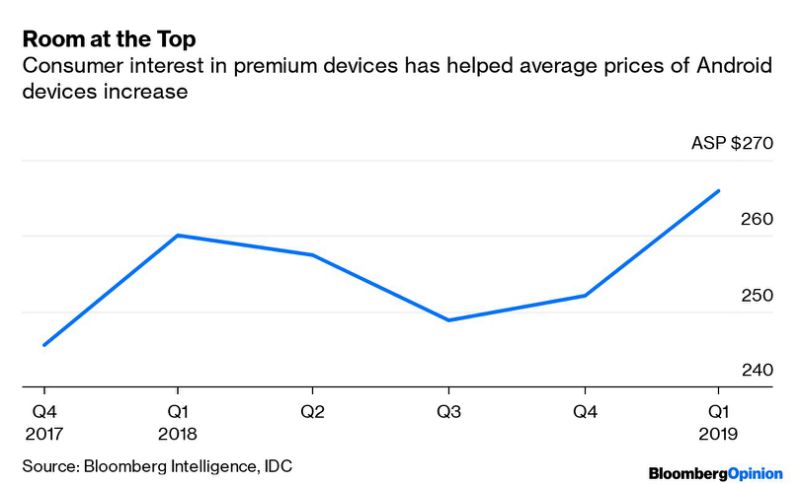

(Bloomberg Opinion) — The biggest rival for Samsung Electronics Co.’s Galaxy Note 10 may not be the most obvious one.
Apple Inc. and Huawei Technologies Inc. are the first names that come to mind. At around $1,000, Samsung’s latest premium device isn’t really competing with the plethora of mid- to low-end offerings from a half-dozen Chinese brands. It comes in two sizes, 6.3-inch at $949 and 6.8-inch starting at $1,099, and includes a stylus. The one innovation is its all-screen front, continuing Samsung’s trend of shrinking the bezel that frames most handsets.
I don’t see the Note as an iPhone challenger, though. Most consumers are either in the iOS camp, or they’re not. Few users cross over between Apple and Samsung because of the annoyances of switching operating system. It’s possible that Samsung will be the first choice of those looking to switch to Android, but the Note 10 probably won’t be the device that compels them to do so.
“The absence of radically new capabilities may be the biggest drawback for the Note 10,” write Sohee Kim and Mark Gurman of Bloomberg News. That’s a fair assessment, and means that there’s probably not enough reason in this offering for iOS fans to end their long-standing relationship with the iPhone.
Huawei is arguably the more formidable challenger. And yet recent difficulties faced by the Chinese company in pushing overseas, especially developed European and American markets, work in the South Korean player’s favor because these are precisely the places Samsung can expect to sell the Note 10.
What’s likely to get customers to make the move is the suite of software innovations that comes with the Note 10. Most notable is its tie-up with Microsoft Corp., which allows the phone to connect and sync with a Windows PC, similar to how iPhones and Macs interact. This could help win over corporate customers as well as as the Bring Your Own Device crowd that use their devices primarily for work. The fact that it’s not a Huawei will make it an easier sell to chief technology officers.
In the end, upgrade apathy is the real threat to the Note 10, as it is for premium devices from Apple or Huawei. For Samsung, the situation is made worse by the knowledge that there’s a far more exciting device on the horizon: the Galaxy Fold.
One reason Apple hates leaks about the next iPhone update is that it hurts sales of the current device. Samsung does itself no favors by telling customers what’s coming next just as they’re pulling out their wallets to buy the what’s on the market now.
Admittedly, Samsung’s first foldable smartphone faces hurdles of its own. Samsung made itself look bad by fumbling the execution of the Fold, as I wrote in April. There’s no doubt that many consumers will shy away from the Fold because of pre-release reports of problems with the bendable screen, which forced Samsung to delay the launch.
On the other hand, a lot of consumers will be excited by the prospect of something radically new, especially given that the Note 10 lacks that wow factor. So it’s likely sales of the Note 10 will be cannibalized by a product that’s yet to hit the market.
We shouldn’t rule out the possibility of strong sales. While the Note 10 may be little different from the Note 9, the predecessor device sold close to 10 million units. Samsung’s S10 handset got off to a strong start when it was launched in March, according to Counterpoint Research, despite being unveiled at the same time as the Fold. Still, I’d argue that the smaller-screened S10 is less of a competitor to the Fold than the Note 10.
If the Fold fails in the hands of reviewers and early adopters when it’s finally released next month, then Samsung may miss out twice on a sale, as some customers decide to shun both devices. That’s the own-goal it will most want to avoid.
To contact the author of this story: Tim Culpan at [email protected]
To contact the editor responsible for this story: Matthew Brooker at [email protected]
This column does not necessarily reflect the opinion of the editorial board or Bloomberg LP and its owners.
Tim Culpan is a Bloomberg Opinion columnist covering technology. He previously covered technology for Bloomberg News.
<p class="canvas-atom canvas-text Mb(1.0em) Mb(0)–sm Mt(0.8em)–sm" type="text" content="For more articles like this, please visit us at bloomberg.com/opinion” data-reactid=”36″>For more articles like this, please visit us at bloomberg.com/opinion
©2019 Bloomberg L.P.






